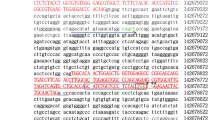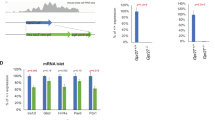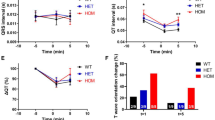Abstract
Insulin action is viewed as a set of branching pathways, with some actions serving to regulate energy metabolism and others to regulate cellular growth and development1. Thus far, available genetic evidence has supported this view. In humans, complete lack of insulin receptors due to mutations of the insulin receptor gene results in severe growth retardation and mild diabetes2,3. In mice, targeted inactivation of insulin receptor sub-strate-1, an important substrate of the insulin receptor kinase, leads to inhibition of growth and mild resistance to the metabolic actions of insulin4,5. To address the question of whether both metabolic and growth-promoting actions of insulin are mediated by the insulin receptor, we have generated mice lacking insulin receptors by targeted mutagenesis in embryo-derived stem (ES) cells. Unlike human patients lacking insulin receptors6–9, mice homozygous for a null allele of the insulin receptor gene are born at term with apparently normal intrauterine growth and development. Within hours of birth, however, homozygous null mice develop severe hyperglycaemia and hyperketonaemia, and die as the result of diabetic ketoacidosis in 48–72 hours. These data are consistent with a model in which the insulin receptor functions primarily to mediate the metabolic actions of insulin.
This is a preview of subscription content, access via your institution
Access options
Subscribe to this journal
Receive 12 print issues and online access
$209.00 per year
only $17.42 per issue
Buy this article
- Purchase on Springer Link
- Instant access to full article PDF
Prices may be subject to local taxes which are calculated during checkout
Similar content being viewed by others
References
Kahn, C.R., Insulin action, diabetogenes, and the cause of type II diabetes. Diabetes 43, 1066–1084 (1994).
Taylor, S.I., Lilly Lecture: molecular mechanisms of insulin resistance. Lessons from patients with mutations in the insulin receptor gene. Diabetes 41, 1473–1490 (1992).
Accili, D. Molecular defects of the insulin receptor gene. Diab. Metab. Reviews. 1, 47–62 (1995).
Tamemoto, H. et al. Insulin resistance and growth retardation in mice lacking insulin receptor substrate-1. Nature 372, 182–186 (1994).
Araki, E. et al. Alternative pathway of insulin signalling in mice with targeted disruption of the IRS-1 gene. Nature 372, 186–190 (1994).
Wertheimer, E., Lu, S.P., Backeljauw, P.P., Davenport, M.L. & Taylor, S.I. Homozygous deletion of the human insulin receptor gene results in leprechaunism. Nature Genet. 5, 71–73 (1993).
Krook, A., Brueton, L. & O'Rahilly, S. Homozygous nonsense mutation in the insulin receptor gene in infant with leprechaunism. Lancet 342, 277–278 (1993).
Hone, J. et al. Homozygosity for a null allele of the insulin receptor gene in a patient with leprechaunism. Hum. Mut. 6, 17–22 (1995).
Jospe, N., Kaplowitz, P.B. & Furlanetto, R.W. Homozygous mutation in the insulin receptor β-subunit of a patient with leprechaunism altering arginine 786 to a stop codon. Abstracts of the 75th Annual Meeting of the Endocrine Society,453 (1993).
Garofalo, R.S. & Rosen, O.M. Insulin and insulinlike growth factor I (IGF-1) receptors during central nervous system development: expression of two immunologically distinct IGF-1 receptor β-subunits. Molec. Cell. Biol. 9, 2806–2817 (1989).
Caro, J.F. et al. Insulin-like growth factor I binding in hepatocytes from human liver, human hepatoma, and normal, regenerating, and fetal rat liver. J. Clin. Invest. 81, 976–981 (1988).
Morgan, D.O., Jarnagin, K. & Roth, R.A. Purification and characterization of the receptor for insulin-like growth factor I. Biochemistry 25, 5560–5564 (1986).
Sun, X.-J. et al. Role of IRS-2 in insulin and cytokine signalling. Nature 377, 173–177 (1995).
Tobe, K., Tamemoto, H., Yamauchi, Y., Yazaki, Y. & Kadowaki, T. Identification of a 190-kDa protein as a novel substrate for the insulin receptor kinase functionally similar to insulin receptor substrate-1. J. Biol. Chem. 270, 5698–5701 (1995).
Moses, A.C. & Tsuzaki, S. Is insulin a growth factor? In Insulin-like growth factors: molecular and cellular aspects. (D. LeRoith, ed.) 245–263 (CRC Press, Boca Raton, 1991).
Schultz, G.A., Hogan, A., Watson, A.J., Smith, R.M. & Heyner, S. Insulin, insulin-like growth factors and glucose transporters: temporal patterns of gene expression in early murine and bovine embryos. Reproof. Fertil. Dev. 4, 361–371 (1992).
Liu, J.-R., Baker, J., Perkins, A.S., Robertson, E.J. & Efstratiadis, A. Mice carrying null mutations of the genes encoding insulin-like growth factor (lgf-1) and type 1 Igf receptor (Igf1r). Cell 75, 59–72 (1993).
Kaku, K., Fiedorek, F.T. Jr., Province, M. & Permutt, M.A. Genetic analysis of glucose tolerance in inbred mouse strains. Diabetes 37, 707–713 (1988).
Flores-Riveros, J.R., Sibley, E., Kastelic, T. & Lane, M.D. Substrate phosphorylation catalyzed by the insulin receptor tyrosine kinase. Kinetic correlation to autophosphorylation of specific sites in the beta subunit. J. Biol. Chem. 264, 21557–21572 (1989).
Soriano, P., Montgomery, C., Geske, R. & Bradley, A. Targeted disruption of the c-src proto-oncogene leads to osteopetrosis in mice. Cell 64, 693–702 (1991).
Li, E., Bestor, T.H. & Jaenisch, R. Targeted mutation of the DNA methyltransferase gene results in embryonic lethality. Cell 69, 915–926 (1992).
Accili, D. & Taylor, S.I. Targeted inactivation of the insulin receptor gene in mouse 3T3-L1 fatty fibroblasts via homologous recombination. Proc. Natl. Acad. Sci. USA 88, 4708–4712 (1991).
Drago, J. et al. Altered striatal function in a mutant mouse lacking D1A dopamine receptors. Proc. Natl. Acad. Sci. USA 91, 12564–12568 (1994).
Accili, D., Mosthaf, L., Ullrich, A. & Taylor, S.I. A mutation in the extracellular domain of the insulin receptor impairs the ability of insulin to stimulate receptor autophosphorylation. J. Biol. Chem. 266, 434–439 (1991).
Wada, J. et al. Cloning of cDNA for the alpha subunit of mouse insulin-like growth factor I receptor and the role of the receptor in metanephric development. Proc. Natl. Acad. Sci. USA 90, 10360–10364 (1993).
Hedo, J.A., Harrison, L.C. & Roth, J. Binding of insulin receptors to lectins: evidence for common carbohydrate determinants on several membrane receptors. Biochemistry 20, 3385–3393 (1981).
Frattali, A.L., Treadway, J.L. & Pessin, J.E. Transmembrane signaling by the human insulin receptor kinase. Relationship between intramolecular beta subunit trans- and cis-autophosphorylation and substrate kinase activation. J. Biol. Chem. 267, 19521–19528 (1992).
Chin, J.E., Tavare, J.M., Ellis, L. & Roth, R.A. Evidence for hybrid rodent and human insulin receptors in transfected cells. J. Biol. Chem. 266, 15587–15590 (1991).
Maegawa, H. et al. Insulin receptors with defective tyrosine kinase inhibit normal receptor function at the level of substrate phosphorylation. J. Biol. Chem. 263, 12629–12637 (1988).
Author information
Authors and Affiliations
Rights and permissions
About this article
Cite this article
Accili, D., Drago, J., Lee, E. et al. Early neonatal death in mice homozygous for a null allele of the insulin receptor gene. Nat Genet 12, 106–109 (1996). https://doi.org/10.1038/ng0196-106
Received:
Accepted:
Issue Date:
DOI: https://doi.org/10.1038/ng0196-106
This article is cited by
-
Osteocalcin of maternal and embryonic origins synergize to establish homeostasis in offspring
EMBO Reports (2024)
-
Dietary supplementation of clinically utilized PI3K p110α inhibitor extends the lifespan of male and female mice
Nature Aging (2023)
-
On the causal relationships between hyperinsulinaemia, insulin resistance, obesity and dysglycaemia in type 2 diabetes
Diabetologia (2021)
-
Insulin-like growth factor receptor signaling in tumorigenesis and drug resistance: a challenge for cancer therapy
Journal of Hematology & Oncology (2020)
-
Insulin: too much of a good thing is bad
BMC Medicine (2020)



